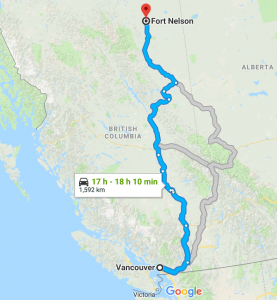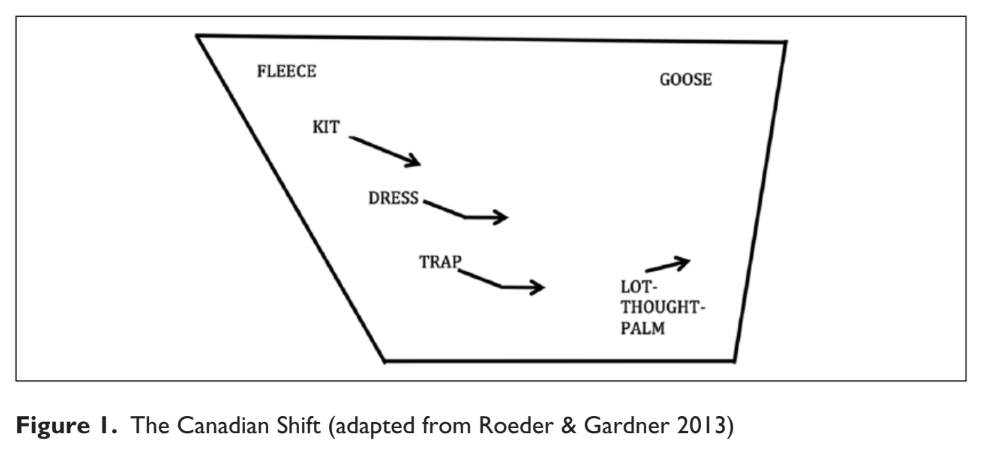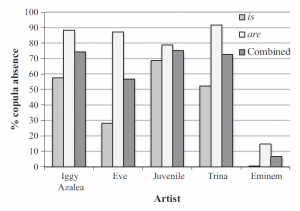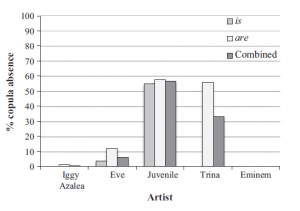Spoilers! If you aren’t up-to-date with Outlander don’t read this. But also, if you’re not up-to-date with Outlander, don’t read anything! Go catch up on Outlander!
Recommended for Time-travelling Bishes, Outlander Observesses, Historical Linguistics Hunnies, and American Dialect Divas.

This series is about the Starz melodrama Outlander, based on the books by Diana Gabaldon, about a woman from the 1970s who time travels to the 1770s to be with her hunky Scottish beau. If you don’t care about any of that, but are interested in learning about early American English, you’ll do fine. Posts 1-4 in the series discuss what we know about how early Americans spake. But I really think you should watch Outlander though.
Welcome back!

Last time we learned that the Royalists gave Virginia and the Carolinas their distinctive dialect and that Outlander producers don’t care out that. This time we’re going to look at the third and fourth groups of English speakers to arrive in America. This information is from online resources compiled by historical linguist Prof. Edward Vajda at Western Washington University.
The third group of colonists were the Quakers. I’m not going to talk about them since there isn’t any overlap with Outlander. But here’s a table of the features of their dialect anyway.
The Quakers(1675-1725)
| Migration: North Midlands of England and Wales to Delaware, Pennsylvania, and New Jersey |
| Feature 1: Phonetic features include the pronunciation of a back rounded [Å] in words such as caught, saw. |
| Feature 2: Also, the pronunciation of [E] instead of [œ] in bad, and, sack, etc. |
| Feature 3: Retention of the syllable final [r] in all places. |
| Words & Expressions: Speakers tried to avoid saying male or female names for animals that might have sexual connotations (bull, cock, etc.), and also avoided names of parts of the body: used rock instead of stone chicken breast/leg =white meat, dark meat. |
| Influence: a great number of euphemisms because of the above |
The last group was the Scot-Irish. This dialect had a huge impact on general American English. It’s also the exact demographic in Outlander. Murtagh and all his friends are these Scots-Irish colonizers, so we should be seeing a lot of this dialect.

However, in the show, Murtagh’s compatriots all appear to be recent arrivals to America. They sound more old world than new. Here is a list of features we could expect to see.
The Scots-Irish (1718-1775)
| Migration: North Britain and Northern Ireland to the Appalachian backcountry |
| Feature 1: Double negatives not nobody |
| Feature 2: Pronouns: hit (it), youns, (ye ones), (possessives) hisn, hern, yorn, theirn and them (them boys instead of their boys) |
| Feature 3: A progressive aspect preposition – a (I’m a talking to you) |
| Feature 4: Compound nouns: men-folk, man-child, kin folks |
| Feature 5: Verbing nouns and nouning verbs: She prettied herself up, I’ll muscle it up, He daddied that child. |
| Words & Expressions: Slow as Christmas, His backbone’s rubbin’ his belly (very hungry), fixin to, pert near, afeared, beholden, took sick, upped an, swan, swanny (swear), golly, dad blamed. special distance words: This here, that there, that yonder |
| Influence: Rural midwest English (because they helped colonize the midwest), and rural southern English. |
| Scots-Irish Expressions in General American: Faster ‘n greased lightning, can’t hold a candle to, sharp as a tack, madder ‘n a wet hen, tuckered out |
As you can see, there are a lot of fun and distinctive dialectal features to choose from. And yet, I don’t recall any of Murtagh’s friends using any of these. Again, this really seems like a missed opportunity.

Wouldn’t it have been great to hear some Appalachian Scots-Irish? For example:
Murtagh’s buddy: I’m a fixin’ ta steal that wagon yonder
Murtagh: Ach aye?
Murtagh’s buddy: I’m afeared hit’s pert near faster ‘n greased lightning!
Murtagh: Ach aye!
Murtagh’s buddy: Yorn kin folks are tuckered out.
Murtagh: Ach aye!?
Obviously, the writers of Outlander should give me a call.

Anyways, it wasn’t until after the Revolutionary War that General American really got going. Western expansion leveled out a lot of the distinctive features of the various east coast dialects from the mid-Atlantic to the Ohio valley. One of the biggest features of General American, which we can thank the Scots-Irish for, is that final [r] sound, which they never dropped.

To recap, we learned that American English was well on its way when Claire and Jamie showed up. It had some unique dialectal features thanks to 4 main groups of colonizers, but also a lot of leveling and uniformity between those groups. So while the depiction of the Americans in Outlander might not be too far off, it is unclear in the show’s portrayal of that time, who is a recent colonizer and who is new-world-born and raised. I suppose I can’t fault the show for that. Rather than showing anachronistic, or inaccurate accents, the show decided to mostly skip dialect opportunities and focus more on the settlers. And maybe that’s for the best.

































